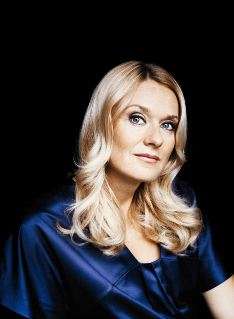|
Back
A Thousand and Four Nights New York
David Geffen Hall, Lincoln Center
09/29/2016 - & September 30, October 1, 2016
Hector Berlioz: Les Nuits d’été, opus 7, H. 81
Nikolai Rimsky-Korsakov: Scheherazade, opus 35
Magdalena Kozená (mezzo-soprano)
New York Philharmonic, Alan Gilbert (conductor)

M. Kozená (© DG/Mathias Bothor)
“Can anyone fail to recognize...the hand of Nature urging me towards the grandest orchestral effects and the Michelangelesque in music?”
Hector Berlioz, Memoirs
Berlioz, never one to hide his light under a bushel, describes his orchestration technique in glowingly unapologetic terms, but is clearly justified in doing so. The numbers fromLes Nuits d’été were originally composed for voice and piano and are therefore more intimate. The later orchestration of the songs was done piecemeal, each an independent work in a different coloristic style. The net result is a great exploration of ensemble hue and vivid imagination. The two men who literally wrote the books on orchestration were paired in this week’s concert by the New York Philharmonic.
Perhaps I simply have bad luck whenever I hear Magdalena Kozená, but her performances have underwhelmed me for years. This concert was no exception. Let’s enumerate:
“Villanelle”: Ms. Kozená cheats a bit by cutting off phrases too soon in order to have sufficient breath for the beginning of the next. To do this sporadically is par for a singer’s course, but she repeated the transgression again and again.
“Le spectre de la rose”: Maestro Gilbert did a good job of lowering the volume of his band to an almost insane quiet, but his singer was still often inaudible. This is a trait that I recognize from previous encounters with this chanteuse.
“Sur les lagunes. Lamento”: A bit better technically, but nowhere near dramatic or expressive enough. Sometimes one feels that she is singing the telephone directory.
“Absence”: The most conventional of the songs, sung well.
“Au cimetière. Clair de lune”: see items 1 through 3.
“L’Ile inconnue”: Orchestrated years later than its mates, the dynamics are more sophisticated, more descriptive. Here the singer was almost drowned in the incessant water imagery, with Gilbert doing a fair amount of shushing of his troops. Even this smallish orchestra overwhelmed this woman repeatedly.
The multifaceted music of Nikolai Rimsky-Korsakov is ridiculously ignored in the United States. There is a respectable amount of magical operas (fifteen in all) – an ethnomusicologist’s trove of treasures, a plethora of beautiful, moving songs, three admirable symphonies and some rare but jewel-like chamber pieces. The few orchestral works that are included in the repertoire are intensely colorful and enthusiastically loved, none more passionately than Scheherazade.
The violin, of course, is the story teller as well as the narrator of the piece. Relatively new concertmaster Frank Huang did a good job, although his tone is a bit one-dimensional. The orchestra, now allowed an opportunity to shine, did so in spades. Especially vibrant was the second movement, a study in scarlet and dynamic contrast. By the conclusion, the sins of the singer were long forgotten.
Stravinsky’s horizontal reading of the wind quintet in The Firebird (all five instruments have individual solos in one section) is a direct result of his tutelage under Rimsky. Somehow the critical and academic communities have forgotten the contributions of the earlier Russian master, who painstakingly built every measure of his music with a fine brush. Modern music would sound very different without the efforts of Nikolai Rimsky-Korsakov. Perhaps one day we will be able to hear Sadko or Le Coq d’or live again.
Fred Kirshnit
|